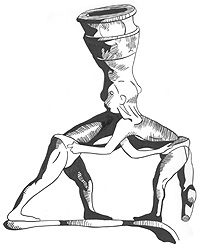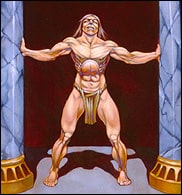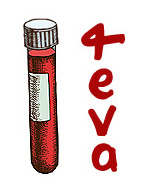A brief view of online sources, demonstrates a vast trove of information on ancient knucklebones. Knuckle bones are the ankle knuckles of a mammal. The ancients preferred sheep, goats and gazelle. It seems I am in line to receive some Rocky Mountain Mule deer knucklebones after this inquiry. In Addendum 2 I will cover a brief inquiry into the ancient game. Addendum 3 will propose a possible game of chance played by both gods and men for my novel, Of Ichor and War.
This game, according only to Herodotus, as far as I know, values the roll of three sixes the highest. The knucklebones were four-sided random devices, that were thrown in twos, fours and fives in various games. The cultural value and antiquity of this practice will not be covered here. I will be able to construct a possible game of knucklebones played by Patroculus and the youth he murdered over the game—sending him into exile as the servant of Achilles—based on readily available sources. That game will be outlined here at year's end as an appendix to of Ichor and War in Addendum 3.
I would like to amend my request form ye gamers to come up with a game based on craps played with two six-sided dice, in which the result of 18 permits the roller to either collect or up the stakes and re-roll. Conversely, a roll of three ones would portend disaster for not only the roller, but all of the players, resulting in the stakeholder [or house or Jove Almighty] collecting the wagers.
I am using three dice as an initial probe into the social-sacral possibilities of a game that values the cast of three sixes the highest and three ones the lowest.
Sitting with three dice over the last few nights, my baboon math brain came up with the following probability curve. Please check it, as I am unqualified. My method was to flip up the first die that could pair with two other rolls and achieve the result.
3 and 18 can only occur when all three die are identical, leaving but one way to arrive at that total.
In the case of 5, for instance, I flip up the three first and see that with that die leading, there is only one possibility, a 3 and two 1s. There are three possible results, a 3-1-1, a 1-3-1 and a 1-1-3. I mark this and then flip up the 2 first. Again there are three possible results. 1s, 2s and 3s have all been consulted, and since with 3 die a 4, 5 or 6 cannot be used, I end this process and mark 6 as the number of ways by which a roll of three die can result in the total of 5.
Note below that the use of three dice results in a rising probability curve that mimics the Greek and Roman systems for counting the days of the month, as rising and declining, rather than a simple Middle eastern-Modern count. The total results are a “gross” or a dozen dozens. [1]
My Result—and If I am correct and have not erred—I will regard Aphrodite and not The Dog to have been invoked in my cause, is:
Inclining 8 [77 results in inclination]
-3... =1 in 144
-4... =3 in 144
-5... =6 in 144
-6... =7 in 144
-7... =9 in 144
-8... =15 in 144
-9... =16 in 144
-10. =18 in 144
…
Declining 8 [77 results in declination]
-11. =18 in 144
-12. =16 in 144
-13. =15 in 144
-14. =9 in 144
-15. =7 in 144
-16. =6 in 144
-17. =3 in 144
-18. =1 in 144
…
I would be thrilled to see what kind of 3-die-six game of chance the galactic brains out there might come up with.
…
Notes
-1. The similarity the the lunar time-keeping systems to this curve, and two the traditional use of dozens in Europe for agricultural folk measurements over more handy counting systems. Dozens are linked to the months of the year and divinities. The use of such heavenly inspired record-keeping, rather than the more practical usage of systems based on fives or tens or 20s based on the human digits, this inquirer suspects is significant.
-2. The uses of this probability curve in constructing random tables for event and ability generation spans role playing and war gaming, and is used most effectively in the random events table for the old Avalon Hill game Samurai.
-3. In terms of social metaphor and invocation of Fortune, note that maximum variation in arriving at the resulting mediocre placement, shows little variability in outcome, representing the plight of the most common. The ancient Greeks were obsessed with combat tournament and races that ignored in retrospect the pack and emphasized only the extreme winners and losers. If we look at the start and termination of the curve we see that among the bottom and top tiers, the highest and lowest 3 outcomes, that there is an extreme difference in likely outcomes.
In a world were kings were slaves to kings and among slaves some had the power of life and death over others, under a heaven ruled by an Almighty Jove who held more power than the aggregate of the remaining divinities, one senses that the ancient gamer and praying caster of the knucklebones read many possibilities into their cast. Further, the additional randomization of the shape of the natural vectors of chance will make outcomes less symmetrical at the extremes than dice, and probably less appealing to the modern, control oriented mind, than to the more reverent ancient mind.











